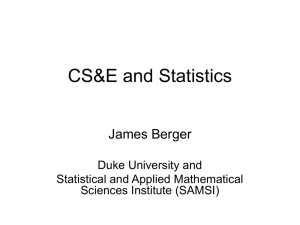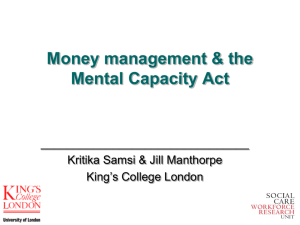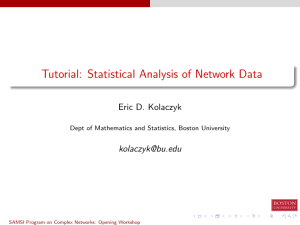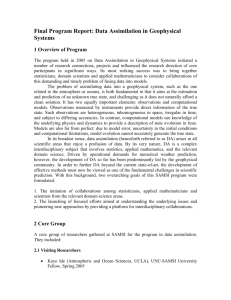Applications
advertisement
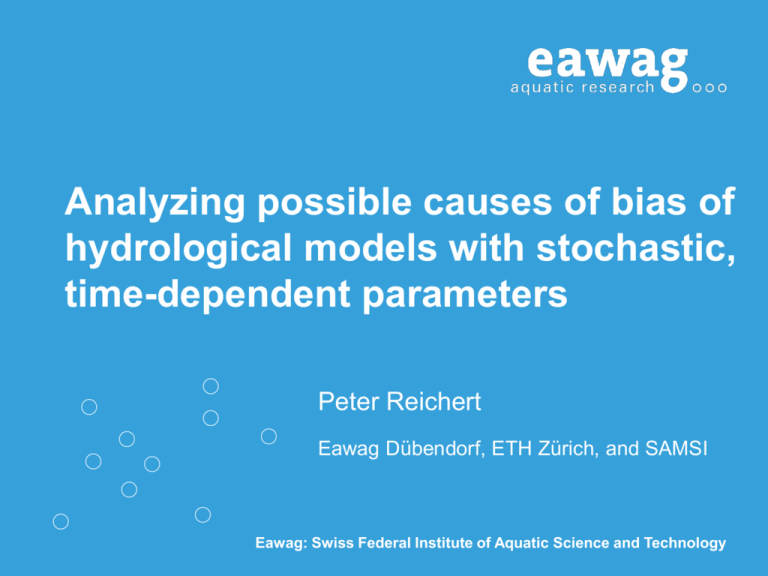
Analyzing possible causes of bias of hydrological models with stochastic, time-dependent parameters Peter Reichert Eawag Dübendorf, ETH Zürich, and SAMSI Eawag: Swiss Federal Institute of Aquatic Science and Technology Contents Motivation Motivation Approach Implementation Application Discussion Approach Implementation Application Discussion SAMSI Transition Workshop May 14-16, 2007 Motivation Motivation Approach Implementation Application Discussion SAMSI Transition Workshop May 14-16, 2007 Motivation Motivation Typical results of a hydrological model 0 200 Motivation 0 50 150 Discussion 850 900 950 1000 1050 time [days] Overall quality of fit demonstrates that the model describes the most relevant mechanisms in the system adequately. SAMSI Transition Workshop May 14-16, 2007 However, remaining systematic deviations of model results from data make uncertainty analysis difficult. qrain [mm/d] 100 100 Application Q [m3/s] Implementation 50 150 Approach Motivation Residuals of Box-Cox transformed results 6 Motivation 2 -6 -4 Discussion 0 Application -2 Implementation nondim. resid. 4 Approach 500 1000 1500 time Problems Heteroscedasticity of residuals (even after Box-Cox transformation). SAMSI Transition Workshop May 14-16, 2007 Autocorrelation of residuals. Motivation Motivation Approach These problems are typical for any kind of deterministic dynamic environmental modelling. Implementation Application Discussion SAMSI Transition Workshop May 14-16, 2007 They make uncertainty analysis difficult as this can only be done if the statistical model assumptions are not seriously violated. Motivation Motivation Suggested solution (Kennedy and O‘Hagan, etc.): Approach Extend the model by a discrepancy or bias term. Replace: Implementation YM (x, θ) y D (x, θ) Ε y (θ) Application Discussion by: YM (x, θ) y D (x, θ) B(x, θ) Ε y (θ) where yD = deterministic model, x = model inputs, q = model parameters, Ey = observation error, B = bias or model discrepancy, YM = random variable representing model results. SAMSI Transition Workshop May 14-16, 2007 The bias term is usually formulated as a non-parametric statistical description of the model deficits (often as a Gaussian Stoachastic Process). Motivation Motivation Advantage of this approach: Approach The statistical description of the model discrepancy allows for improved uncertainty analysis. Implementation Application Discussion Disadvantage: Lack of understanding of the cause of the discrepancy makes it difficult to extrapolate. We are interested in a technique that supports identification of the causes of model discrepancies. This can lead to an improved model formulation that reduces the discrepancies. SAMSI Transition Workshop May 14-16, 2007 This cannot be done by a purely statistical approach, but statistics can be supportive. Motivation Motivation Approach Implementation Causes of deficits of deterministic models: Errors in parameter values. Application Errors in model structure. Discussion Errors in model input. Inadequateness of a deterministic description of systems that contain intrinsic non-deterministic behaviour due to influence factors not considered in the model, model simplifications (e.g. aggregation, adaptation, etc.), SAMSI Transition Workshop May 14-16, 2007 chaotic behaviour. Motivation Motivation Approach Because of these deficits we cannot expect a deterministic model to describe nature appropriately. Implementation Application Discussion Pathway for improving models: 1. Reduce errors in deterministic model structure to improve average behaviour. 2. Add adequate stochasticity to the model structure to account for random influences. This requires the combination of statistical analyses with scientific judgment. SAMSI Transition Workshop May 14-16, 2007 This talk is about support of this process by statistical techniques. Approach Motivation Approach Implementation Application Discussion SAMSI Transition Workshop May 14-16, 2007 Approach Approach Motivation Approach Implementation Application Discussion Questions: 1. How to make a deterministic, continuous-time model stochastic? 2. How to distinguish between deterministic and stochastic model deficits? Replacement of differential equations (representing conservation laws) by stochastic differential equations can violate conservation laws and does not address the cause of stochasticity directly. SAMSI Transition Workshop May 14-16, 2007 It seems to be conceptually more satisfying to replace model parameters (such as rate coefficients, etc.) by stochastic processes, as stochastic external influence factors usually affect rates and fluxes rather than states directly. Approach Motivation Approach Implementation Application Discussion SAMSI Transition Workshop May 14-16, 2007 Approach Motivation Note that the basic idea of this approach is very old. Approach Implementation Application The original formulation was, however, limited to discrete-time systems with slowly varying driving forces (e.g. Beck 1987). Discussion Our suggestion is to extend this original approach to continuous-time systems; allow for rapidly varying external forces; embed the procedure into statistical „biasmodelling“ techniques. SAMSI Transition Workshop May 14-16, 2007 This requires more complicated numerical techniques and more extensive analyses of the results. Implementation Motivation Approach Implementation Application Discussion SAMSI Transition Workshop May 14-16, 2007 Implementation Model Motivation Approach Deterministc model: y D (x, θD ) Implementation Application Discussion Consideration of observation error: YM (x, θ M ) y D (x, θ D ) E y (θ O ) qD x yD SAMSI Transition Workshop May 14-16, 2007 θD θ M θO yM qO qM x yM f M (y x, θM ) Model Motivation Approach Implementation Model with parameter i time-dependent: YM(i) x, θM(i) y M x, θM,-i ,q Application t M,i (θ ) i P θ M(i) θ M,-i i θP qPi Discussion qM,-i x t qM,i yM SAMSI Transition Workshop May 14-16, 2007 f M(i) y x, θ M(i) f M y x, θ M , i ,q Mt ,i f P q Mt ,i θiP dq Mt ,i Time Dependent Parameter Motivation Approach The time dependent parameter is modelled by a mean-reverting Ornstein Uhlenbeck process: dq t ( ) q t ( ) q W dWt ( ) Implementation Application Discussion This has the advantage that we can use the analytical solution: 2 q t q s ~ Nq (q s )e (t s ) , W 1 e 2 (t s ) 2 or, after reparameterization: t s t s 2 t s s 2 q q ~ Nq (q q )e , 1 e W2 , 2 1 SAMSI Transition Workshop May 14-16, 2007 2 t θ P (qini , q , , ) Inference Motivation Approach Implementation Application Discussion We combine the estimation of constant model parameters, θ M,-i , with state estimation of the time-dependent parameter(s), q Mt ,i , and with the estimation of (constant) parameters of the Ornstein-Uhlenbeck process(es) of the time dependent parameter(s), θ iP . SAMSI Transition Workshop May 14-16, 2007 Inference Motivation Approach Implementation Gibbs sampling for the three different types of parameters. Conditional distributions: simulation model (expensive) f θ M , i x, q Mt ,i , θiP , y f θ M , i x, q Mt ,i , y f (θ M , i ) f M ( i ) y x, θ M , i , q Mt ,i Application Discussion Ornstein-Uhlenbeck process (cheap) f θiP x, θ M , i ,q Mt ,i , y f θiP q Mt ,i f (θiP ) f P q Mt ,i θiP Ornstein-Uhlenbeck process (cheap) fq t M ,i x, θ M , i , θ , y f P q i P t M ,i θ i P f y x, θ M(i ) M , i simulation model (expensive) x SAMSI Transition Workshop May 14-16, 2007 Tomassini et al. 2007 ,q t M ,i qPi qM,-i yM t qM,i Inference Metropolis-Hastings sampling for each type of parameter: Motivation Approach Implementation Application Discussion f θ , y f θ f θ M , i x, q Mt ,i , θiP , y f θ M , i x, q Mt ,i , y f (θ M , i ) f M ( i ) y x, θ M , i , q Mt ,i i P x, θ M , i ,q Mt ,i i P q Mt ,i f (θiP ) f P q Mt ,i θiP Multivariate normal jump distributions for the parameters qM and qP. This requires one simulation to be performed per suggested new value of qM. f q Mt ,i x, θ M , i , θiP , y f P q Mt ,i θiP f M ( i ) y x, θ M , i , q Mt ,i SAMSI Transition Workshop May 14-16, 2007 The discretized Ornstein-Uhlenbeck parameter, q Mt ,i , is split into subintervals for which OU-process realizations conditional on initial and end points are sampled. This requires the number of subintervals simulations per complete new time series of q Mt ,i. Tomassini et al. 2007 Estimation of Hyperparameters by Cross - Validation Motivation Approach Implementation Application Discussion SAMSI Transition Workshop May 14-16, 2007 Due to identifiability problems we select the two hyperparameters (,) by cross-validation: ( , ) : psl log f ( yi y i , , ) max ( , ) i Tomassini et al. 2007 Estimation of Hyperparameters by Cross - Validation Motivation Approach Implementation For a state-space model of the form dξ ξ (t , x, θ D ) : F (ξ, x, θ D ) dt Application Yi (ti , x, q D ) Ey ,i (q O ) Discussion E y N (0, Σ) we can estimate the pseudo-likelihood from the sample: f ( yi y i , , ) 1 f ( y, , ) d f ( yi y i , ) 1 (2 ) 1/ 2 SAMSI Transition Workshop May 14-16, 2007 1 ( Σ 1 ) 1 1 1 / 2 ii ( Σ ) exp ii 2 n k ( Σ 1 )ij (k ) (k ) yi i 1 y j j j i ( Σ ) ii 2 Tomassini et al. 2007 Application Motivation Approach Implementation Application Discussion SAMSI Transition Workshop May 14-16, 2007 Application Hydrological Model Motivation Simple Hydrological Watershed Model (1): Approach Application dhs (qrain qrunoff ) qet qlat qgw dt Discussion dhgw Implementation dt qgw qbf qdp dhr qrunoff qlat qbf qr dt SAMSI Transition Workshop May 14-16, 2007 Kuczera et al. 2006 Hydrological Model Simple Hydrological Watershed Model (2): Motivation Approach Implementation Application Discussion qrain f rain rain (t ) qgw f sat qgw,max A 4 qrunoff f sat f rain rain (t ) qbf k bf hgw qet 1 exp( ket hs ) f pet pet (t ) qlat f sat qlat,max 1 qdp kdp hgw B qr kr hr 2 f sat 3 5 6 1 7 1 1 sF exp( ks hs ) sF 1 Qr f Q Aw qr C 8 SAMSI Transition Workshop May 14-16, 2007 8 3 1 3 Kuczera et al. 2006 model parameters initial conditions standard dev. of obs. err. „modification parameters“ Hydrological Model Motivation Simple Hydrological Watershed Model (3): 1-exp( 0.0 ks=0.02/mm, sF=400 ks=0.01/mm, sF=400 ks=0.02/mm, sF=100 0 SAMSI Transition Workshop May 14-16, 2007 200 400 600 800 hs [mm] 0.8 0.6 0.4 0.6 0.4 0.2 fs at [-] Discussion 0.2 k e t h s ) [-] 0.8 Application ket=0.01/mm ket=0.02/mm ket=0.005/mm 0.0 Implementation 1.0 1.0 Approach 0 200 400 600 800 hs [mm] Model Application Motivation Approach Implementation Application Discussion Data set of Abercrombie watershed, New South Wales, Australia (2770 km2), kindly provided by George Kuczera (Kuczera et al. 2006). Box-Cox transformation applied to model and data to decrease heteroscedasticity of residuals. Step function input to account for input data in the form of daily sums of precipitation and potential evapotranspiration. Daily averaged output to account for output data in the form of daily averaged discharge. SAMSI Transition Workshop May 14-16, 2007 Analyses and Prior Distributions Motivation Approach Implementation Application Discussion A) Estimation of constant parameters: Independent lognormal distributions for all parameters (8+3+1=11) with the exception of the measurement standard deviation (1/), keeping correction factors (frain, fpet, fQ) equal to unity. B) Estimation of time-dependent parameters: SAMSI Transition Workshop May 14-16, 2007 Ornstein-Uhlenbeck process applied to the log of the parameter. Hyperparameters: =1d, =0.2 (22%) fixed, only estimation of initial value and mean (0 for log frain, fpet, fQ). Constant parameters as above. Estimation of Constant Parameters Motivation A) Estimation of Constant Parameters: Approach Implementation Application Discussion Try to find a reasonably good fit in which the deterministic model with constant parameters reproduces the major features of the data. The goal of the second analysis with timedependent parameters will then be to support finding causes of remaining model deficiencies. SAMSI Transition Workshop May 14-16, 2007 Estimation of Constant Parameters Prior and Posterior Marginals: 0 2 4 6 8 0.010 0 50 Application 100 150 200 0 100 150 200 2.0 6 8 10 2.0 0.00 8 10 12 4 0.0 0.4 0.8 1.2 s_F 0.008 0.012 0.004 0 1.5 6 0.000 100 5 10 1.0 4 0 0.008 250 20 0.004 k_s 0 0.5 2 8 800 0.000 sd_Q_trans 0.0 0 k_r 0 0.012 0.6 0.0 4 400 800 400 0.008 0.4 1.0 2.0 0.0 2 k_dp 0 0.004 0.2 q_gw_max 1.0 500 0 k_bf 0.000 0.0 q_lat_max 0.000 0.004 0.008 0.012 SAMSI Transition Workshop May 14-16, 2007 50 k_et 0 200 Discussion h_r_ini 0.000 0.010 Implementation h_gw_ini 0.020 h_s_ini 0.020 Approach 0.000 Motivation 0.02 0.04 0 500 1000 1500 2000 Estimation of Constant Parameters 0 50 1000 0 50 150 Q 150 time Discussion 80 120 1000 1500 1000 1500 1000 1500 time 100 0 40 0 hgw 500 250 Application 0 500 25 15 400 0 5 200 0 Qrunoff time 500 2 6 tsresval$Time -6 -2 nondim. resid. 0 SAMSI Transition Workshop May 14-16, 2007 qrain 1050 50 0 950 qrain 900 hs 850 Implementation 500 1000 1500 Qlat Qbf Qdp Approach 150 Q 150 Motivation 50 0 Max. post. simulation with constant parameters: Estimation of Constant Parameters Results of Constant Parameter Fit: Motivation Approach Implementation Application Discussion SAMSI Transition Workshop May 14-16, 2007 The hydrological model with constant parameters leads to a fit that reasonably well reproduces the features shown by the data; a simulation with physically meaningful behaviour of state variables with respect to their values and to their time scales of variation; identifiable model parameters (with the exception of the initial condition of hr). Despite this basic agreement, the remaining systematic deviations violate simple statistical assumptions and make uncertainty analysis difficult. Estimation of Time-Dependent Parameters B) Estimation of time-dependent parameters: Motivation Approach Implementation Application Discussion Sequentially replace constant parameters by timedependent parameters. Try to learn from the results about deficits of the deterministic model structure as well as about the need for stochastic model extensions. How to learn from the results of the analysis? SAMSI Transition Workshop May 14-16, 2007 1. 2. 3. 4. 5. Analysis of temporal behaviour of parameters. Analysis of posterior distributions of const. parameters. Analysis of behaviour of model results. Analysis of indicators of the quality of the fit. Explorative analysis of the relationships between timedependent parameters and system variables. 1. Temporal Behaviour of Parameters Time dependent parameter k_s Implementation ks Approach 0.005 Application 0.020 Motivation Discussion 0 500 1000 1500 SAMSI Transition Workshop May 14-16, 2007 0.010 0.020 0.030 ks time 0 500 1000 time 1500 1. Temporal Behaviour of Parameters Time dependent parameter f_rain 0.5 Application 1.0 Implementation frain Approach 1.5 2.0 Motivation Discussion 0 500 1000 1500 1.4 1.0 0.6 frain 1.8 time 0 SAMSI Transition Workshop May 14-16, 2007 500 1000 time 1500 1. Temporal Behaviour of Parameters Motivation Implementation fQ Approach Application 0.6 1.0 1.4 1.8 Time dependent parameter f_Q Discussion 0 500 1000 1500 1.0 0.6 fQ 1.4 1.8 time 0 SAMSI Transition Workshop May 14-16, 2007 500 1000 time 1500 1. Temporal Behaviour of Parameters Time dependent parameter s_F Implementation sF Approach 100 Application 300 500 Motivation Discussion 0 500 1000 1500 200 100 sF time 0 SAMSI Transition Workshop May 14-16, 2007 500 1000 time 1500 1. Temporal Behaviour of Parameters Assessment: Motivation Approach Implementation Application Discussion SAMSI Transition Workshop May 14-16, 2007 In cases with highly dynamic external forcing, identified parameter time series are difficult to interpret directly. The variation of width measures of the posterior time-dependent parameter allows us to distinguish time periods during which we can gain information about variations in the parameter from periods during which we cannot. In our example, this varies somewhat from one parameter to the other, with a general tendency that we can learn more during periods with rain events than during dry weather periods. 2. Posterior of Constant Parameters Results for time dependent parameter k_s h_gw_ini h_r_ini 0 50 100 150 200 0 0.000 Implementation 0.000 4 8 0.020 Approach h_s_ini 0.020 Motivation 0 50 100 150 200 0.0 0.2 0.4 0.6 Application 1.5 1.5 0.0 0.000 0.004 0.008 0.012 q_gw_max 0.0 400 Discussion q_lat_max 0 k_et 0 2 4 8 10 12 0.008 0.012 0.000 0.004 0.008 0.012 0.008 s_F 0.000 10 20 sd_Q_trans 0 SAMSI Transition Workshop May 14-16, 2007 0.0 0.5 1.0 4 1.5 2.0 6 8 10 0 4 8 600 0.004 2 k_r 0 0 0.000 0 k_dp 600 k_bf 6 0 500 1000 1500 2000 0.0 0.4 0.8 1.2 12 2. Posterior of Constant Parameters Results for time dependent parameter f_rain h_gw_ini h_r_ini 0 50 100 150 200 0 0.000 Implementation 0.000 4 8 0.020 Approach h_s_ini 0.020 Motivation 0 50 100 150 200 0.0 0.2 0.4 0.6 Application 1.5 1.5 0.0 0.000 0.004 0.008 0.012 0 2 4 6 8 10 12 0.012 0.000 0.008 k_s 0.5 1.0 1.5 2.0 0.00 6 8 10 12 0.012 0.0 0.4 0.8 1.2 s_F 0.000 0 10 0 150 20 0.004 0.008 0.008 sd_Q_trans 0.0 4 0 4 8 600 0.004 2 k_r 0 0 0.000 0 k_dp 600 k_bf SAMSI Transition Workshop May 14-16, 2007 q_gw_max 0.0 400 Discussion q_lat_max 0 k_et 0.02 0.04 0 500 1000 1500 2000 2. Posterior of Constant Parameters Results for time dependent parameter f_Q h_gw_ini h_r_ini 0 50 Application 150 200 0 100 150 200 4 6 8 10 12 1.5 0.0 0.000 0.008 1.5 2.0 0.00 6 8 10 12 0.012 0.0 0.4 0.8 1.2 s_F 0.000 10 1.0 4 0.008 k_s 0 0.5 2 0 4 8 0.004 0 150 20 sd_Q_trans 0.0 0 k_r 600 0.012 0.6 1.5 2 0 600 0.008 0.4 q_gw_max k_dp 0 0.004 0.2 0.0 400 0 k_bf 0.000 0.0 q_lat_max 0.000 0.004 0.008 0.012 SAMSI Transition Workshop May 14-16, 2007 50 k_et 0 Discussion 100 0 0.000 Implementation 0.000 4 8 0.020 Approach h_s_ini 0.020 Motivation 0.02 0.04 0 500 1000 1500 2000 2. Posterior of Constant Parameters Results for time dependent parameter s_F h_gw_ini h_r_ini 0 50 Application 150 200 0 100 150 200 4 6 8 10 12 1.5 0.0 0.000 0.008 k_s 10 0 0.5 1.0 2 4 1.5 2.0 0.00 6 8 10 0 4 8 0.004 0 150 20 sd_Q_trans 0.0 0 k_r 600 0.012 0.6 1.5 2 0 600 0.008 0.4 q_gw_max k_dp 0 0.004 0.2 0.0 400 0 k_bf 0.000 0.0 q_lat_max 0.000 0.004 0.008 0.012 SAMSI Transition Workshop May 14-16, 2007 50 k_et 0 Discussion 100 0 0.000 Implementation 0.000 4 8 0.020 Approach h_s_ini 0.020 Motivation 0.02 0.04 0.012 0.0 0.4 0.8 1.2 12 2. Posterior of Constant Parameters Assessment: Motivation Approach Implementation Application Discussion The marginal posterior distributions of some parameters depend significantly on which of the parameters was made time-dependent. In particular, making the modification factor for rain intensity time dependent, changes the posterior distributions of the other parameters strongly. This demonstrates the importance of addressing input (rainfall) intensity carefully. SAMSI Transition Workshop May 14-16, 2007 3. Behaviour of Model Results 1000 50 time 0 time 500 1000 1500 40 0 0 20 0 400 Qrunoff time 500 1000 1500 5 tsresval$Time -5 0 nondim. resid. 0 500 1000 hs 0 150 350 1500 1500 Qlat Qbf Qdp 1000 0 40 hgw 100 500 SAMSI Transition Workshop May 14-16, 2007 qrain 1050 qrain 950 150 Q Discussion 900 100 200 850 Implementation Application 50 0 Approach 150 Q Motivation 100 200 Results for time dependent parameter k_s 3. Behaviour of Model Results 50 950 1000 1050 200 50 time 0 1000 1500 1000 1500 1000 1500 0 60 100 time 0 hgw 140 500 0 500 20 40 0 300 0 Qrunoff time 500 5 tsresval$Time -5 nondim. resid. 0 SAMSI Transition Workshop May 14-16, 2007 hs Discussion 900 100 200 Q Application 850 qrain Implementation qrain 200 0 Approach 500 1000 1500 Qlat Qbf Qdp Q Motivation 100 200 Results for time dependent parameter f_rain 3. Behaviour of Model Results qrain 50 0 Approach 150 Q Motivation 100 200 Results for time dependent parameter f_Q Implementation 950 1000 1050 0 40 80 time 500 1000 1500 10 20 0 0 200 Qrunoff time 0 500 1000 1500 -6 0 4 tsresval$Time 500 1000 1500 Qlat Qbf Qdp 0 nondim. resid. hs 1500 150 300 1000 0 hgw 500 SAMSI Transition Workshop May 14-16, 2007 qrain 150 50 time 0 Discussion 900 100 200 Q Application 850 3. Behaviour of Model Results 950 1000 1000 1500 1000 1500 150 300 1500 100 time 0 500 25 0 10 300 0 Qrunoff time 500 0 4 tsresval$Time -6 nondim. resid. 0 500 1000 1500 Qlat Qbf Qdp 0 0 40 hgw 1000 hs 0 qrain 50 time 500 SAMSI Transition Workshop May 14-16, 2007 qrain 1050 150 Q Discussion 900 100 200 850 Implementation Application 50 0 Approach 150 Q Motivation 100 200 Results for time dependent parameter s_F 3. Behaviour of Model Results Assessment: Motivation Approach Implementation Application Discussion SAMSI Transition Workshop May 14-16, 2007 The basic features of the solutions are not changed by introducing a time-dependent parameter. For some of the parameters, making them timedependent significantly reduces the bias in model output, for others this is not the case. 4. Quality of Fit Improvement with time-dependent parameters: Motivation Nash-Sutcliffe indices: Approach Implementation Application Discussion SAMSI Transition Workshop May 14-16, 2007 ks frain fQ sF kr fpet qgw,max qlat,max kdp kbf base 0.83 0.78 0.68 0.64 0.59 0.57 0.54 0.53 0.53 0.53 0.53 NS 1 M 2 ( y y i i ) i 2 ( y y ) i i Assessment: Input (frain) and output (fQ) corrections. Potential for soil / runoff model (ks, SF) improvements. Some potential for river and evaporation improvements. Random or deterministic? 5. Relationsship with Model Variables Scatter plot of k_s vs. model variables SAMSI Transition Workshop May 14-16, 2007 q_dp 0.020 0.5 1.5 q_r 0.020 ks 0.012 0.3 0.1 4 f_sat 2.5 0.020 0.012 ks 0.020 0.012 ks 0.012 0.1 0.3 0.5 0.7 0.020 0.012 ks 0.020 0.012 0.020 0.020 0.020 0.012 ks 0.020 0.012 ks q_bf q_runoff q_et q_rain 0.01 0.03 0.05 0.0 1.0 2.0 3.0 1.0 2.0 3.0 4.0 10 15 0.012 5 2 3 h_r h_gw 0.012 ks 0.020 0.012 ks 0 1 20 40 60 80 250 h_s Q Discussion ks 150 60 ks 20 Application ks Implementation 0.020 0.012 ks 0.020 0.012 Approach ks Motivation 0.1 0.3 0.5 0.7 q_lat 0.5 q_gw 1.5 5. Relationsship with Model Variables Scatter plot of f_rain vs. model variables 20 Application 60 20 Q 60 100 160 20 h_s 60 100 1.2 0.8 frain 1.2 0.8 frain 1.2 frain 1.2 100 0.8 Implementation 0.8 frain 1.2 0.8 Approach frain Motivation 0.5 h_gw 1.5 2.5 0.05 h_r 0.15 f_sat 5 10 15 20 1.0 2.0 0.06 q_bf SAMSI Transition Workshop May 14-16, 2007 2.0 0.8 frain 1.2 0.2 0.6 q_dp 1.0 0.5 1.5 q_r 2.5 1.2 0.8 frain 1.2 0.8 frain 1.2 1.0 q_runoff 0.8 0.02 0.0 q_et frain 1.2 0.8 frain q_rain 3.0 1.2 0 0.8 frain 1.2 0.8 frain 1.2 0.8 frain Discussion 0.2 0.6 q_lat 0.5 1.5 q_gw 0.25 5. Relationsship with Model Variables Scatter plot of f_Q vs. model variables 20 Application 50 Q 150 20 40 h_s 60 80 1.2 0.8 fQ 1.2 0.8 fQ 1.2 fQ 1.2 60 0.8 Implementation 0.8 fQ 1.2 0.8 Approach fQ Motivation 0.5 1.5 2.5 3.5 h_gw 0.05 h_r 0.15 0.25 f_sat 10 15 0.015 q_bf 2.0 0.6 q_dp 0.5 1.5 q_r 2.5 1.2 0.8 fQ 0.1 0.3 q_lat 1.2 1.2 0.2 0.4 1.2 0.8 fQ 1.2 1.0 q_runoff 0.8 0.8 0.005 0.0 q_et fQ 1.2 q_rain fQ 0.8 1.0 2.0 3.0 4.0 0.8 5 fQ 0 SAMSI Transition Workshop May 14-16, 2007 fQ 1.2 0.8 fQ 1.2 0.8 fQ Discussion 0.2 0.6 q_gw 1.0 5. Relationsship with Model Variables Scatter plot of s_F vs. model variables 20 Application 60 100 Q 200 20 40 60 80 h_s 250 150 sF 250 150 sF 250 150 sF 150 150 Implementation sF sF 250 Approach 250 Motivation 1 h_gw 2 3 4 0.05 h_r 0.15 0.25 f_sat 5 10 15 0.015 q_bf 2.0 150 q_dp 0.5 1.5 q_r 250 150 0.1 0.3 q_lat sF 0.2 0.4 0.6 0.8 sF 250 150 1.0 q_runoff 250 150 sF 150 sF 0.005 sF 0.0 q_et 250 q_rain SAMSI Transition Workshop May 14-16, 2007 250 1.0 2.0 3.0 250 0 150 sF 250 150 sF 150 sF 250 Discussion 2.5 0.2 0.6 q_gw 1.0 5. Relationsship with Model Variables Assessment: Motivation Approach Implementation Application Discussion SAMSI Transition Workshop May 14-16, 2007 Most of the time dependent parameters do not show deterministic variation with any of the system variables. The only exception is the parameter ks of the soil submodel that varies significantly with the saturated area (which it parameterizes). Conclusions Assessment: Motivation Approach Implementation Application Discussion Stochasticity seems to be the dominating cause of deviations of model results from measurements. This is likeli to be dominated by input (rainfall) uncertainty. The highest chance to find an improvement of the deterministic model is for the soil/runoff submodel of the hydrological model. It seems difficult to significantly improve the model by changes to the groundwater and river sub-models. SAMSI Transition Workshop May 14-16, 2007 Hydrological Model Model extensions: Motivation Approach Extension 1: Modification of runoff flux: Implementation Application qrunoff Discussion e f rain rain (t ) rain f sat (1 f sat ) e erain rain K f rain ( t ) rain rain f rain rain (t ) Extension 2: Modification of sat. area funct.: f sat SAMSI Transition Workshop May 14-16, 2007 hse1 hse 2 e1 (1 ) e 2 e1 K1 hs K 2 hse 2 Both extensions lead to three more model parameters. Hydrological Model Motivation Previous results: Extended models: Nash-Sutcliffe indices: Nash-Sutcliffe indices: Approach Implementation Application Discussion SAMSI Transition Workshop May 14-16, 2007 ks frain fQ sF kr fpet qgw,max qlat,max kdp kbf base 0.83 0.78 0.68 0.64 0.59 0.57 0.54 0.53 0.53 0.53 0.53 ext. 1 ext. 2 0.72 0.54 Assessment: Model extension 1 significantly improves the description of the system. Approach Motivation Approach Implementation Application Discussion SAMSI Transition Workshop May 14-16, 2007 Hydrological Model Motivation Approach Implementation Application Discussion Next Steps Redo analysis with model extension 1. Compare remaining stochastic uncertainty with knowledge on input uncertainty. Do uncertainty analysis for model with extensions 1 and input uncertainty. Investigate alternative ways of describing rainfall input uncertainty SAMSI Transition Workshop May 14-16, 2007 Conclusions The application of the technique led to the discovery of improvements of the deterministic model structure as well as to the inclusion of stochasticity. Discussion Motivation Approach Implementation Application Discussion SAMSI Transition Workshop May 14-16, 2007 Discussion Discussion Motivation Approach Implementation Application Discussion • The suggested procedure seems to fulfill the expectations of supporting the identification of model deficits and of introducing stochasticity into a deterministic model. • There is need for future research in the following areas: • Explore alternative ways of learning from the identified parameter time series. • Different formulation of time-dependent parameter (for some applications smoother behaviour). • Improve efficiency (linearization, emulation). SAMSI Transition Workshop May 14-16, 2007 • Learn from more applications. Transition On-going projects in various fields: Motivation Approach Implementation • Applications for gaining more experience: • Reichert et al.: • Cintron et al.: hydrological model epidemiological model Application Discussion • Emulation of dynamic models: • • • • Reichert et al.: White et al.: Liu et al.: Gosling et al.: simple physical-based prior extended physical-based prior statistical prior emulation of time step • Linearization for improving efficiency: • Paulo et al.: • Liu et al.: SAMSI Transition Workshop May 14-16, 2007 emulation of linearized model direct use of linearized model Other persons: Bayarri, Santner, Pitman, O‘Hagan, Wolpert More ideas on the way. Post-program workshop next year? Acknowledgements Motivation Approach Implementation Application Discussion Development of the technique: Hans-Rudolf Künsch, Roland Brun, Lorenzo Tomassini, Mark Borsuk, Christoph Buser. • Hydrological example Johanna Mieleitner, George Kuczera. • Interactions at SAMSI: Susie Bayarri, Tom Santner, Gentry White, Ariel Cintron, Fei Liu, Rui Paulo, Robert Wolpert, John Paul Gosling, Tony O‘Hagan, Bruce Pitman, Jim Berger, and many more. SAMSI Transition Workshop May 14-16, 2007 I would like to thank in particular to Jim Berger and Susie Bayarri for setting up this program that lead to a very stimulating and fruitful stay for me at SAMSI.
